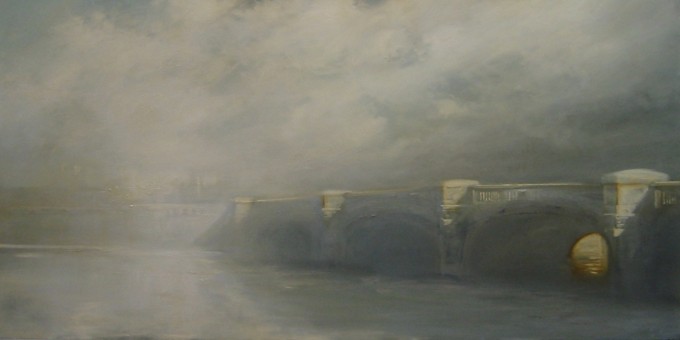Ray Turner at J. Cacciola Galleries
Jan/Feb 2003|Raymond J. Steiner
SUBTLETY, SUGGESTION, AND sensitivity to nuanced color — it would be ungracious to ask for more in a landscape painter. California based artist Ray Turner recently treated New York City viewers with a dozen of his large-scale paintings at the J. Cacciola Galleries,more than enough to allow for a judicious assessment of his work. Brushwork, scale, handling of values, composition, and, above all, an eye for nature, all confirm an ease with his subject matter and expertise with his medium. Almost “poetic” — a term that I usually try to avoid when I write about paintings but which perfectly fits here — Turner’s vision of natural phenomena as exemplified in this show is one that goes far beyond what we can see and, insofar as any painter can, seems to attempt a penetration into pur material world’s ultimate insubstantiality.
Although the “hard” facts of rocky precipices, ships, trees, fields, and buildings make up his subject matter, through his interplay of light and shadow, his soft-edge demarcations between objects and atmosphere, as well as between horizons and skies, Turner leads us into as world of ‘becoming’, a world that seems to shift before our eyes. With the exception of the bridge over the River Seine (The Seine, 42×84) which boldly stands forth, Turner’s other “subjects” — towering tors (The Gorge, 28×40; The Pass, 40×60), the Louvre darkly looming in the distance (Storm over the Louvre, 36×48), ships caught between a reddened sky and darkened sea (Three Ships, 36×48) — appear to merge out of and back into some primordial melange that is struggling to birth forth matter, definitive objects, a world. In a sense, all things become — as the title of the show suggests — a “river” of malleable matter, changeable color, and inconstant flux. This is powerful work — yet the artist accomplishes his impact without overstatement, without gimmicky flourish. He seldom overstates, allowing nature to “speak” for herself. Colors are muted, brushstroke strong without distraction — in brief, the artist (as the serious artist ought) does not get in the way of his paintings, allowing for color and form to carry his intent. By the time you read this critique, Turner’s exhibition will have been taken down — but, if you want art that moves you slightly off your complacent center, don’t let this deter you from seeking him out.
